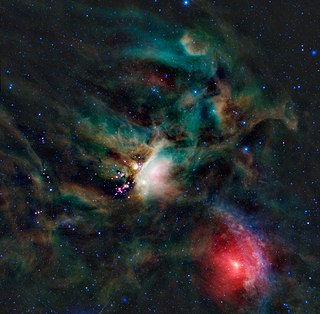
The galactic coordinate system is a celestial coordinate system in spherical coordinates, with the Sun as its center, the primary direction aligned with the approximate center of the Milky Way Galaxy, and the fundamental plane parallel to an approximation of the galactic plane but offset to its north. It uses the right-handed convention, meaning that coordinates are positive toward the north and toward the east in the fundamental plane.

The Great Attractor is a gravitational anomaly in intergalactic space and the apparent central gravitational point of the Laniakea Supercluster. The observed anomalies suggest a localized concentration of mass millions of times more massive than the Milky Way. However, it is inconveniently obscured by our own Milky Way's galactic plane, lying behind the Zone of Avoidance (ZOA), so that, in visible light wavelengths, the Great Attractor is difficult to observe directly.

Spiral galaxies form a class of galaxy originally described by Edwin Hubble in his 1936 work The Realm of the Nebulae and, as such, form part of the Hubble sequence. Most spiral galaxies consist of a flat, rotating disk containing stars, gas and dust, and a central concentration of stars known as the bulge. These are often surrounded by a much fainter halo of stars, many of which reside in globular clusters.

Hipparcos was a scientific satellite of the European Space Agency (ESA), launched in 1989 and operated until 1993. It was the first space experiment devoted to precision astrometry, the accurate measurement of the positions of celestial objects on the sky. This permitted the first high-precision measurements of the intrinsic brightnesses, proper motions and parallaxes of stars, enabling better calculations of their distance and tangential velocity. When combined with radial velocity measurements from spectroscopy, astrophysicists were able to finally measure all six quantities needed to determine the motion of stars. The resulting Hipparcos Catalogue, a high-precision catalogue of more than 118,200 stars, was published in 1997. The lower-precision Tycho Catalogue of more than a million stars was published at the same time, while the enhanced Tycho-2 Catalogue of 2.5 million stars was published in 2000. Hipparcos' follow-up mission, Gaia, was launched in 2013.

The Sloan Digital Sky Survey or SDSS is a major multi-spectral imaging and spectroscopic redshift survey using a dedicated 2.5-m wide-angle optical telescope at Apache Point Observatory in New Mexico, United States. The project was named after the Alfred P. Sloan Foundation, which contributed significant funding.

The Scutum–Centaurus Arm, also known as Scutum-Crux arm, is a long, diffuse curving streamer of stars, gas and dust that spirals outward from the proximate end of the Milky Way's central bar. The Milky Way has been posited since the 1950s to have four spiral arms — numerous studies contest or nuance this number. In 2008, observations using the Spitzer Space Telescope failed to show the expected density of red clump giants in the direction of the Sagittarius and Norma arms. In January 2014, a 12-year study into the distribution and lifespan of massive stars and a 2013-reporting study of the distribution of masers and open clusters both found corroboratory, though would not state irrefutable, evidence for four principal spiral arms.

The 1.2 meter Millimeter-Wave Telescope at the Harvard-Smithsonian Center for Astrophysics and its twin instrument at CTIO in Chile have been studying the distribution and properties of molecular clouds in our galaxy and its nearest neighbours since the 1970s. The telescope is nicknamed "The Mini" because of its unusually small size. At the time it was built, it was the smallest radio telescope in the world. Together, "The Mini" and its twin in Chile have obtained what is by far the most extensive, uniform, and widely used galactic survey of interstellar carbon monoxide. "The Mini" is currently in operation from October to May each year.

The Milky Way is the galaxy that includes our Solar System, with the name describing the galaxy's appearance from Earth: a hazy band of light seen in the night sky formed from stars that cannot be individually distinguished by the naked eye. The term Milky Way is a translation of the Latin via lactea, from the Greek γαλακτικός κύκλος, meaning "milky circle." From Earth, the Milky Way appears as a band because its disk-shaped structure is viewed from within. Galileo Galilei first resolved the band of light into individual stars with his telescope in 1610. Until the early 1920s, most astronomers thought that the Milky Way contained all the stars in the Universe. Following the 1920 Great Debate between the astronomers Harlow Shapley and Heber Curtis, observations by Edwin Hubble showed that the Milky Way is just one of many galaxies.

The Gould Belt is a local, partial ring of stars in the Milky Way, about 3000 light years long, tilted toward/away from the galactic plane by about 16 to 20 degrees. It contains many O- and B-type stars, amounting to the nearest star-forming regions of the local spiral arm, to which the Sun belongs. It has been largely superseded in definition by the Radcliffe Wave. The Sun is closest to the Orion (constellation) part of its recent star-created sub-belt of the many times longer Orion Arm. This means the solar system is about 325 light years away, though about 100 light years further to the more extensive Radcliffe Wave's stars, dust and gas in the Taurus Molecular Cloud.
The Deep Lens Survey is an ultra-deep multi-band optical survey of seven 4 square degree fields. Mosaic CCD imagers at the National Optical Astronomy Observatory's Blanco and Mayall telescopes are being used. The deep fields took five years to complete (2001–2006), in four bands: B, V, R, and z', to 29/29/29/28 mag per square arcsecond surface brightness. Optical transient events and supernova candidates are released in real time.

The UKIRT Infrared Deep Sky Survey or UKIDSS is an astronomical survey conducted using the WFCAM wide field camera on the United Kingdom Infrared Telescope on Mauna Kea in Hawaii. Survey observations were commenced in 2005.
The H I Parkes All Sky Survey (HIPASS) is a large survey for neutral atomic hydrogen (H I). Most of the data was taken between 1997 and 2002 using CSIRO's 64 m Parkes Telescope. HIPASS covered 71% of the sky and identified more than 5000 galaxies; the major galaxy catalogs are: the "HIPASS Bright Galaxy Catalog", the southern HIPASS catalog (HICAT), and the northern HIPASS catalog (NHICAT) Discoveries include over 5000 galaxies, the Leading Arm of the Magellanic Stream and a few gas clouds devoid of stars.
Sagittarius A or Sgr A is a complex radio source at the center of the Milky Way which contains a supermassive black hole. It is located in the constellation Sagittarius, and is hidden from view at optical wavelengths by large clouds of cosmic dust in the spiral arms of the Milky Way.

Retrograde motion in astronomy is, in general, orbital or rotational motion of an object in the direction opposite the rotation of its primary, that is, the central object. It may also describe other motions such as precession or nutation of an object's rotational axis. Prograde or direct motion is more normal motion in the same direction as the primary rotates. However, "retrograde" and "prograde" can also refer to an object other than the primary if so described. The direction of rotation is determined by an inertial frame of reference, such as distant fixed stars.
The Palomar Transient Factory, was an astronomical survey using a wide-field survey camera designed to search for optical transient and variable sources such as variable stars, supernovae, asteroids and comets. The project completed commissioning in summer 2009, and continued until December 2012. It has since been succeeded by the Intermediate Palomar Transient Factory (iPTF), which itself transitioned to the Zwicky Transient Facility in 2017/18. All three surveys are registered at the MPC under the same observatory code for their astrometric observations.
The galactic ridge is a region of the inner galaxy that is coincident with the galactic plane of the Milky Way. It can be seen from Earth as a band of stars which is interrupted by 'dust lanes'. In these 'dust lanes' the dust in the gaseous galactic disk blocks the visible light of the background stars. Due to this, many of the most interesting features of the Milky Way can only be viewed in X-rays. Along with the point X-ray sources which populate the Milky Way, an apparently diffuse X-ray emission concentrated in the galactic plane is also observed. This is known as the galactic ridge X-ray emission (GRXE). These emissions were originally discovered by Diana Worrall and collaborators in 1982, and since then the origins of these emissions have puzzled astrophysicists around the globe.

PALFA is a large-scale survey for radio pulsars at 1.4 GHz using the Arecibo 305-meter telescope and the ALFA multibeam receivers. It is the largest and most sensitive survey of the Galactic plane to date.
In astrobiology and planetary astrophysics, the galactic habitable zone is the region of a galaxy in which life might most likely develop. The concept of a galactic habitable zone analyzes various factors, such as metallicity and the rate and density of major catastrophes such as supernovae, and uses these to calculate which regions of a galaxy are more likely to form terrestrial planets, initially develop simple life, and provide a suitable environment for this life to evolve and advance. According to research published in August 2015, very large galaxies may favor the birth and development of habitable planets more than smaller galaxies such as the Milky Way. In the case of the Milky Way, its galactic habitable zone is commonly believed to be an annulus with an outer radius of about 10 kiloparsecs (33,000 ly) and an inner radius close to the Galactic Center.
The VVV Survey is an ESO public survey scanning the Milky Way bulge and adjacent section of the southern mid-plane in the near-infrared. This area, is active in star formation and very rich in dust and interstellar gas, which makes it impossible to see through in the visible as the extinction and crowding are high. There are though, some ‘clear windows’ thought the whole survey area, where optical surveys can be carried out, like MACHO, OGLE and EROS.

Faint Images of the Radio Sky at Twenty-Centimeters, or FIRST, was an astronomical survey of the Northern Hemisphere carried out by the Very Large Array. It was led by Robert H. Becker, Richard L. White, and David J. Helfand, who came up with the idea for the survey after they had completed the VLA Galactic Plane survey in 1990, as well as Michael D. Gregg and Sally A. Laurent-Muehleisen. The survey was started 50 years after the first systematic survey of the radio sky was completed by Grote Reber in April 1943.














